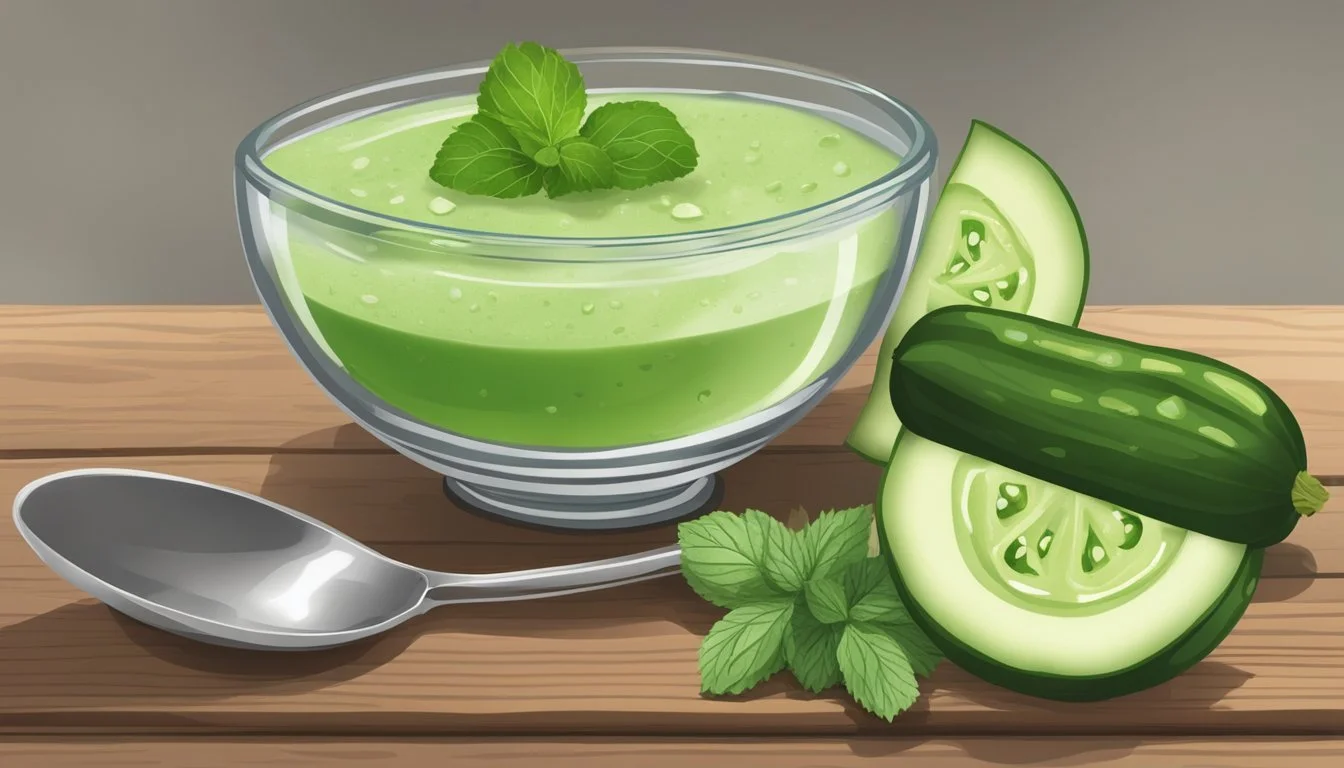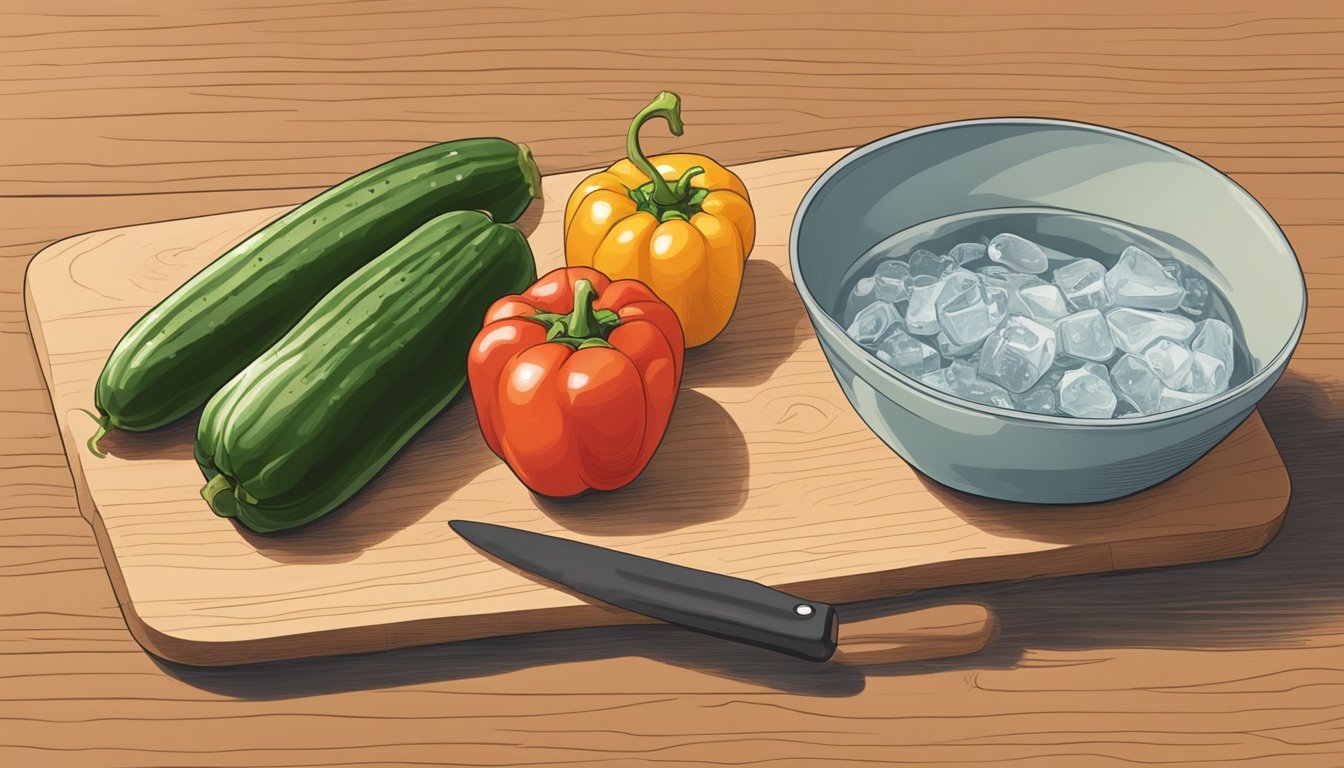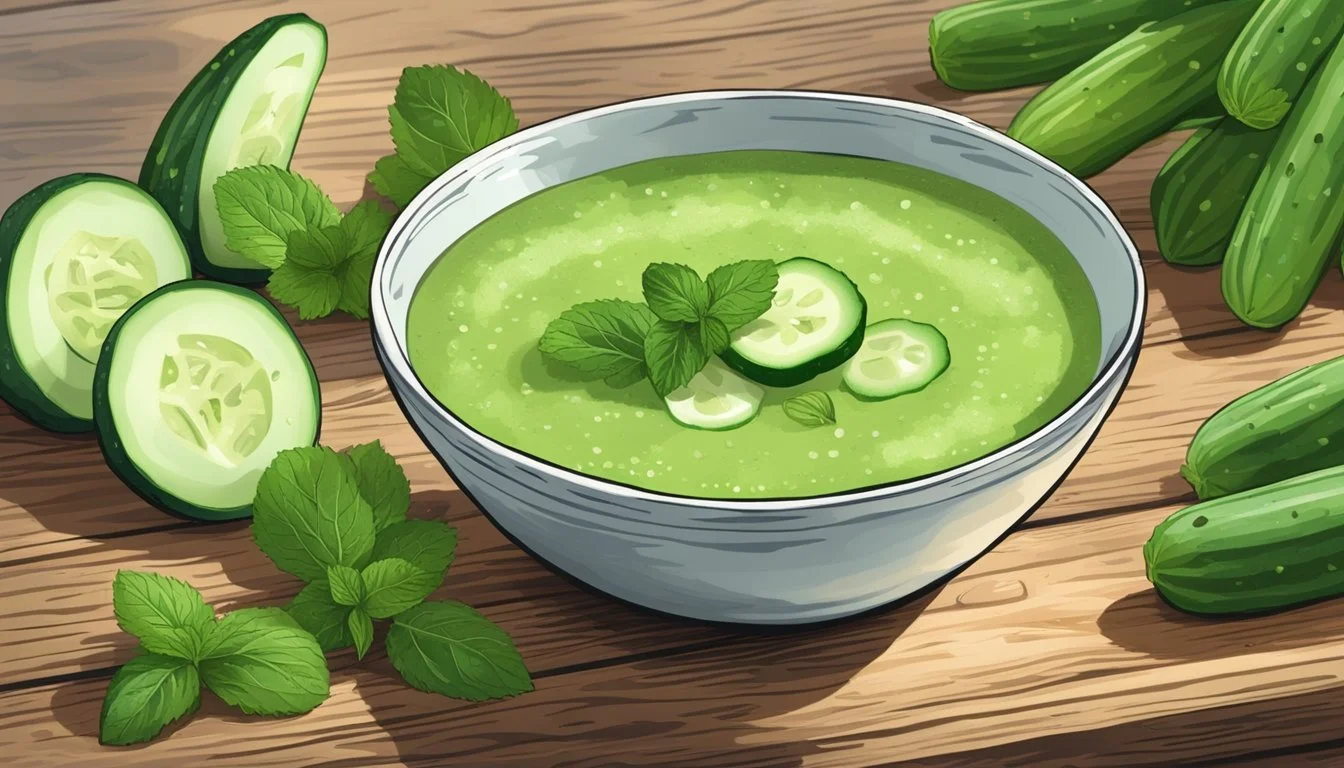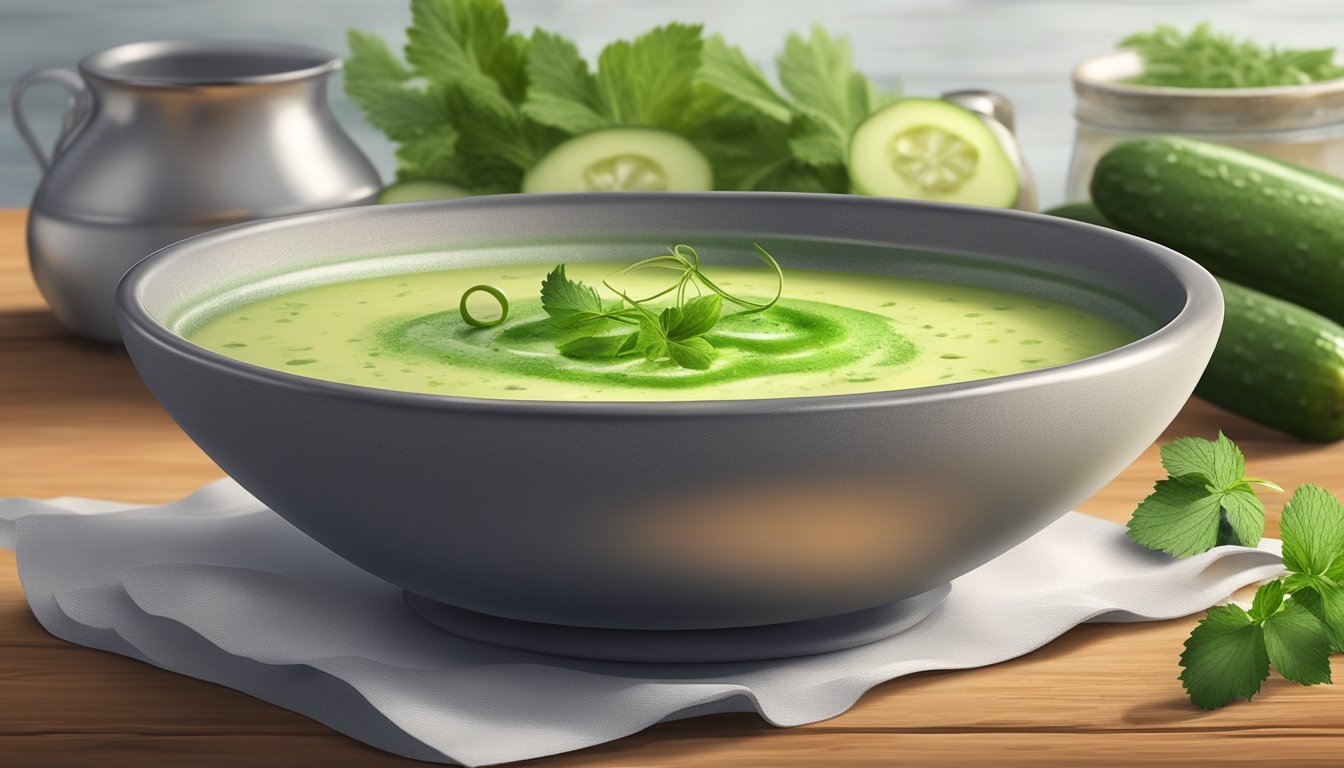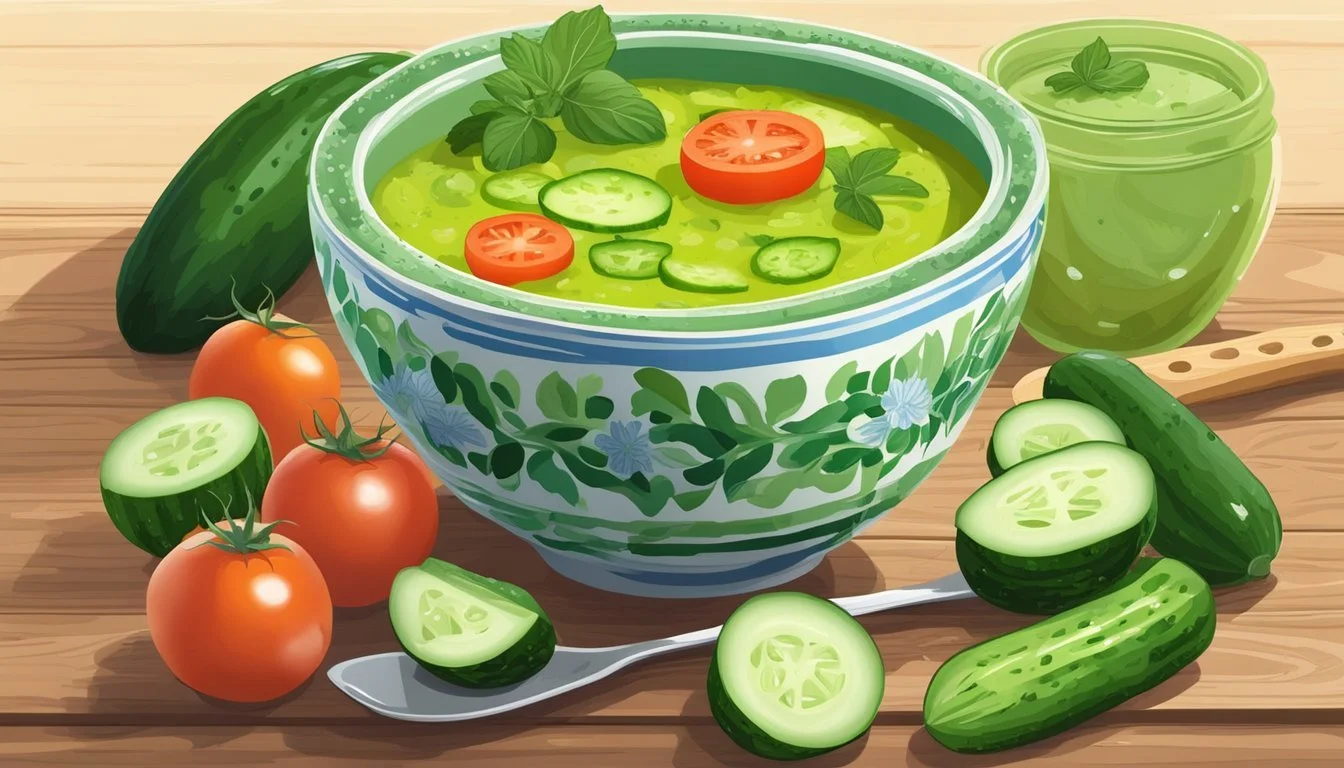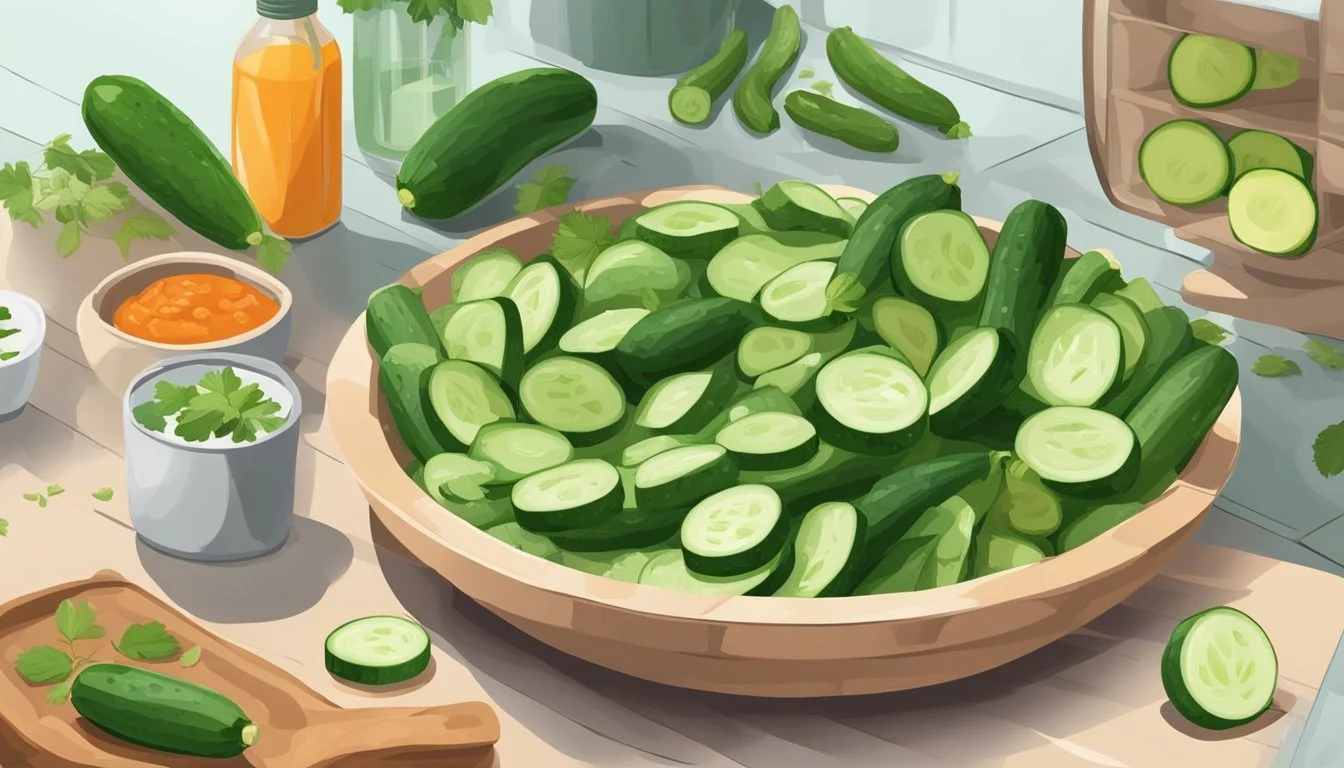Cucumber Peel Gazpacho
The Perfect Summer Hydration Solution
Cucumber gazpacho represents the essence of summer in a bowl, embodying hydration and refreshment in each spoonful. This chilled soup, traditionally found in Spanish cuisine, has taken on new twists and variations, making it a versatile dish suited for a variety of palates. With cucumbers as its main ingredient, this gazpacho not only offers a delicate and slightly sweet flavor but also serves as a perfect way to cool down during the hot months.
In crafting cucumber peel gazpacho, the use of the cucumber's skin is a clever nod to both nutrition and waste reduction. The peel, which is often discarded, is a source of additional fiber and vitamins. This enhances the gazpacho with a depth of flavor and an array of health benefits. When blended with ingredients such as Greek yogurt, lime, and fresh herbs like cilantro and coriander, the outcome is a silky, creamy soup that is as nourishing as it is invigorating.
As a dish, cucumber gazpacho lends itself well to embellishments and garnishes. Whether topped with finely chopped shallot, diced cucumber, or a sprinkle of scallions, the added textures and colors elevate the visual appeal and contribute a pleasing crunch. Its simplicity and elegance make it a standout choice for summer dining, whether as a starter for an al fresco meal or a light, standalone refreshment on a warm afternoon.
The Essence of Cucumber Gazpacho
Cucumber Gazpacho is a quintessentially refreshing cold soup, often savored during the warmer seasons. Its prime ingredient, cucumber, imparts a remarkably hydrating quality, making the dish delightfully light and perfect for heat relief.
This chilled soup typically combines cucumbers with a selection of vibrant herbs and citrus notes. Lemon, with its bright acidity, is a classic component that enhances the crispness of the cucumbers. Meanwhile, herbs such as mint and basil contribute to the gazpacho's aromatic profile, introducing a layer of complexity to the flavor.
Preparation Basics:
Cucumbers: Peeled and chopped to form the gazpacho base
Herbs: Mint or basil for a fresh undertone
Acid: Lemon juice to elevate the freshness
Blending: Achieving a smooth or textured consistency
One should not underestimate the simplicity of the ingredients, as they come together to build a sophisticated and robust palate. Whether served as a starter, a palate cleanser, or a light meal, cucumber gazpacho remains true to its purpose: to refresh and satisfy with its cool, silky embrace.
While recipes may vary, the essence of cucumber gazpacho lies in its ability to balance flavor and refreshment. It's a testament to the fact that luxurious taste experiences can arise from the simplest of concoctions.
Garnishing Tips:
Texture: Add finely diced cucumbers for a crunch
Color: Garnish with herb leaves or edible flowers
In sum, cucumber gazpacho stands out for its hydrating properties, its interplay of flavors, and its undeniable refreshment factor, making it a beloved choice for those seeking solace from the heat in a bowl of cool, herby goodness.
Selecting Ingredients
Preparing a delightful Cucumber Peel Gazpacho hinges on the freshness and quality of the ingredients. Each selection contributes uniquely to the soup's flavor profile and texture.
Opting for the Best Cucumbers
The cucumbers are the cornerstone of gazpacho. They should be fresh, crisp, and firm to the touch. For the peel gazpacho, one might consider using English or Persian cucumbers for their thin, tender skins that are rich in nutrients and easy to blend.
Preferred Cucumbers: English or Persian
Desired Qualities: Fresh, firm, tender-skinned
Herbs and Spices
Herbs and spices are vital for enhancing the gazpacho's complexity. Fresh herbs like dill, mint, or parsley provide aromatic lift, while ground black pepper and sea salt are essentials for seasoning.
Fresh Herbs: Choose from dill, mint, or parsley
Seasonings: Fine sea salt and fresh ground black pepper
Additional Vegetables and Fruits
Additional vegetables like ripe tomatoes and red onions add depth, while a touch of garlic offers a piquant accent. For a well-rounded flavor, high-quality extra-virgin olive oil and a dash of vinegar are irreplaceable.
Tomatoes: Ripe and juicy
Onions: Red onions, finely chopped
Garlic: Minced, adjust to taste
Olive Oil: Extra-virgin for richness
Vinegar: A dash for a tangy brightness
Preparation Techniques
Creating the perfect cucumber peel gazpacho requires attention to detail in the preparation stages. Peeling cucumbers correctly and chopping them uniformly can significantly affect the soup's consistency and flavor.
The Art of Peeling and Chopping
Firstly, one peels the cucumbers to ensure a smooth texture and to avoid the bitter taste peel can sometimes introduce. Using a vegetable peeler, remove the skin in long, steady strips. Next, chopping the cucumbers uniformly is crucial for an even blend; one should aim for pieces small enough to be easily puréed but large enough to avoid juicing during chopping.
Blending for the Perfect Texture
For a velvety consistency, the use of a high-speed blender is recommended. Combine the peeled and chopped cucumbers with other fresh ingredients—such as herbs, garlic, and onions—and blend until the mixture is creamy. The time spent blending may vary, but a steady high speed should be maintained to achieve the desired smoothness.
Chilling for Enhanced Flavors
Chilling the gazpacho allows the flavors to meld and intensify. After blending, one should transfer the soup to an airtight container and refrigerate it. Standard chilling time ranges from one to two hours, but overnight refrigeration is an option for those seeking a more pronounced flavor profile. The fridge plays a pivotal role in this step, as a consistent and cold temperature is essential for proper chilling.
Garnishes and Toppings
In enhancing the flavors and textures of Cucumber Peel Gazpacho, the selection of garnishes and toppings is crucial. They not only add visual appeal but also introduce complementary flavors or contrasting textures to the soup.
Traditional Garnishes
Traditionally, Cucumber Peel Gazpacho is garnished with ingredients that echo the flavors found within the soup itself. A few traditional garnishes include:
Chopped Herbs: A sprinkle of fresh parsley or cilantro offers a burst of color and freshness.
Croutons: For a delightful crunch, one can add homemade or store-bought croutons.
Extra-virgin Olive Oil: A drizzle of high-quality olive oil can enhance the soup's richness.
Freshly Ground Pepper: This provides a subtle heat that complements the coolness of the gazpacho.
Creative Toppings
For those looking to elevate their Cucumber Peel Gazpacho with more innovative toppings, the following can serve as inspiration:
Herb-infused Oils: By infusing olive oil with herbs like basil or thyme, one can create a visually stunning and flavor-packed drizzle.
Vegetable Ribbons: Thinly sliced cucumber or bell pepper ribbons add a refreshing crunch and visual flair.
Microgreens: A handful of microgreens can contribute a concentrated burst of flavor as well as an elegant touch.
Edible Flowers: Edible flowers, such as nasturtiums or violas, make for an enchanting and flavorful decoration.
By thoughtfully choosing garnishes and toppings, one can transform Cucumber Peel Gazpacho from a simple soup to a culinary masterpiece.
Nutritional Profile
Cucumber Gazpacho is a nutritiously dense dish that offers a myriad of health benefits. The main ingredient, cucumber, is renowned for its high water content, which aids in hydration. Additionally, cucumbers provide a good source of vitamin K, essential for blood clotting and bone health.
Vitamins and Antioxidants: Another critical aspect of this dish's nutritional profile is its vitamin C and antioxidant content. Cucumbers contain vitamin C, an antioxidant that supports the immune system, skin health, and tissue repair. Gazpacho often includes other ingredients such as bell peppers and tomatoes, which further contribute to the antioxidant properties due to their high vitamin C and other phytonutrient contents.
Low in Calories: Gazpacho is also recognized for being low in calories, making it an excellent choice for those monitoring their calorie intake.
Nutrient Breakdown per Serving:
Calories: Low
Water Content: High
Vitamin C: Good source
Antioxidants: Contains phytonutrients
Vitamin K: Good source
The soup's composition makes it a refreshing option that does not compromise on nutritional value. The ingredients not only provide essential vitamins but also minerals and antioxidants, which play a role in preventing oxidative stress and inflammation.
Cucumbers, together with the accompaniments in gazpacho, such as garlic, onions, and leafy greens, contribute to a nutrient-rich profile offering a spectrum of vitamins and minerals beneficial for overall health.
Serving Suggestions
Cucumber peel gazpacho serves as a versatile dish that can be perfectly positioned as an appetizer or a light lunch. Its hydrating qualities and aesthetic appeal make it an excellent choice for dinner parties or as a refreshing starter.
Pairings
Cucumber gazpacho pairs well with a variety of foods. For an appetizer course, one can consider coupling it with:
Crusty Bread: A slice of artisan bread offers a crunchy contrast to the smooth soup.
Seafood: Shrimp or crab complements the gazpacho's coolness with a delicate, sweet flavor.
Salads: A light, citrusy salad can balance the cucumber's freshness.
For a more fulfilling light lunch, a sandwich with mild flavors, like chicken or turkey, pairs nicely without overpowering the soup's delicate taste.
Presentation Tips
The presentation of cucumber gazpacho can enhance its appeal, particularly at a dinner party. Consider these tips for a beautiful serving:
Garnishes: Add a swirl of thinned sour cream, a sprinkle of microgreens, or edible flowers for visual interest.
Bowls: Serve in clear bowls to showcase the gazpacho's vibrant green color.
Consistency: For a beautiful texture, blend until smooth and creamy.
By focusing on these presentation details, one can elevate the simple act of serving gazpacho into an art form, impressing guests with both flavor and visual presentation.
Dietary Variations
Cucumber Gazpacho can be easily adapted to meet various dietary requirements, ensuring that this refreshing soup can be enjoyed by everyone.
Vegan and Dairy-Free Options
For those who follow a vegan or dairy-free diet, traditional dairy products like Greek yogurt or sour cream can be substituted without compromising the creamy texture of the gazpacho. Coconut yogurt is an excellent vegan alternative that provides a similar richness and tang. One can also opt for dairy-free sour cream products available on the market, or simply omit these elements to maintain the soup's bright and fresh profile.
Use coconut yogurt
Opt for dairy-free sour cream alternatives
Gluten-Free Adaptations
Although traditional Cucumber Gazpacho is inherently gluten-free, care should be taken with any additional garnishes or side dishes. For individuals with gluten sensitivities, it is critical to ensure all ingredients, such as store-bought broth or crackers served alongside, are labeled gluten-free.
Key Points for Gluten-Free Cucumber Gazpacho:
Confirm all ingredients are certified gluten-free
Be cautious with store-bought products and read labels carefully
Storing and Preservation
When it comes to preserving the freshness of cucumber gazpacho, refrigeration is key. Leftovers should be transferred to an airtight container as this limits exposure to air and bacteria that could spoil the soup. It's imperative to store gazpacho in the fridge to maintain its refreshing taste and prevent bacterial growth.
Here are essential tips for storing cucumber gazpacho:
Refrigerate promptly: Place the gazpacho in the refrigerator without delay after preparation to preserve its flavors and prevent spoilage.
Temperature: Keep the refrigerator temperature at or below 40°F (4°C) to ensure optimal preservation.
Airtight containers: Use containers with tight-fitting lids to keep the gazpacho sealed off from potential contaminants.
Consume quickly: Gazpacho is best enjoyed within 1-2 days of making it, as it is a no-cook dish and relies on the freshness of its ingredients.
Can You Freeze Gazpacho?
While freezing is possible, it may affect the texture and flavor profile of the gazpacho. It is generally recommended to enjoy gazpacho fresh rather than frozen.
By adhering to these storage principles, one maximizes the shelves life and quality of cucumber gazpacho, ensuring it remains a hydrating and delightful dish when served again.
Common Questions and Tips
In crafting a delightful Cucumber Peel Gazpacho, one may wonder how to manage leftovers or personalize the flavor profile. The following subsections tackle these queries with practical tips.
Dealing with Leftovers
If there are leftovers, it is best to store the gazpacho in an airtight container in the refrigerator. Gazpacho typically keeps well for up to two days, though the flavors will continue to meld and evolve. If separation occurs, which is natural, simply stir or blend briefly before serving again.
Adjusting Flavors to Taste
When adjusting flavors, consider the balance between bitter and sweet elements. If the gazpacho tastes too bitter, it may benefit from a touch of sweetness. Consider adding a small amount of maple syrup; start with a teaspoon, taste, and adjust as necessary. Conversely, if the soup is too sweet, a bit of lemon juice can add zest and balance. Experiment with herbs and spices to find the perfect blend that suits your palate. Small adjustments can lead to a harmonious balance of flavors in this hydrating soup.
Cultural and Historical Context
Gazpacho finds its roots deeply embedded in Spain's culinary history. This traditional dish has evolved from an ancient Roman meal known as "salmorejo," which served as a source of sustenance for soldiers. Today, Gazpacho is synonymous with Spain's hot summer days, providing a cool respite from the heat.
The integration of cucumbers into Gazpacho enhances the soup's hydrating qualities. In Spain, cucumbers are valued for their cooling effect and mild flavor, which complements the vibrant tomatoes that are the staple of this dish. Over time, variations such as Cucumber Peel Gazpacho have emerged, still honoring the traditional essence while offering a unique take on the classic.
Key Ingredients of Traditional Gazpacho:
Tomatoes
Cucumbers
Peppers
Garlic
Olive oil
With the history stretching back to ancient times, Gazpacho has been reimagined throughout the centuries by blending indigenous ingredients such as cucumbers and peppers with culinary techniques introduced by various cultures. This blend reflects Spain's rich tapestry of historical influences and its ability to adapt and embrace change while maintaining its traditional gastronomic identity.
Exploring Variations
Cucumber peel gazpacho serves as a versatile base for numerous variations, each offering a distinct blend of flavors and presentations. Whether infused with regional ingredients or reimagined through contemporary tweaks, this dish showcases its adaptability.
Regional Twists on Gazpacho
Spanish Influence: Traditional Spanish gazpachos often incorporate ripe tomatoes and peppers, but regions like Andalusia sometimes integrate melons for a sweeter note.
Mediterranean Varieties: Countries bordering the Mediterranean Sea may opt for green gazpachos, highlighting herbs and incorporating avocado for creaminess.
In each region, the core concept of a chilled, hydrating soup remains, while ingredients reflect local palates and produce availability.
Contemporary Interpretations
Fruit-infused Creations: Modern chefs often experiment by adding fruits such as cantaloupe or watermelon, creating melon gazpachos that juxtapose sweetness against the cucumber's coolness.
Avant-garde Compositions: Some may embrace unconventional flavors, incorporating ingredients like ginger or even green tea, to give the traditional cucumber gazpacho a contemporary zest.
The essence of gazpacho invites creativity, as contemporary kitchens push the boundaries by introducing unexpected ingredients, while retaining the refreshing character of the original recipe.


